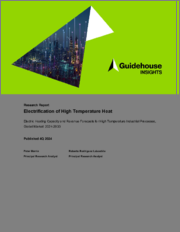
|
시장보고서
상품코드
1596028
세계의 고온열 전기화 시장Electrification of High Temperature Heat: Electric Heating Capacity and Revenue Forecasts for High Temperature Industrial Processes, Global Market 2024-2033 |
||||||
산업용 열 수요의 약 절반은 400 ° C 이상에서 작동하는 열 공정 용입니다. 화석연료의 연소에 의존하고 있는 열효율의 저하하기 어려운 섹터에서 발생합니다. 규모로 수행하는 것은 일반적으로 비용이 많이 들고 기존 인프라를 파괴하고 기술적으로 어려운 것으로 생각되어 왔습니다. 탄소 회수, 수소, 바이오매스 등 연소 기반의 경로에 초점이 맞추어지는 경우가 많습니다.
그러나 고온 공정의 전기화가 산업계의 탈탄소화를 추진하는 중요한 원동력이 되는 것을 시사하는 증거도 증가하고 있습니다. 기본 옵션입니다. 전열 기술은 또한 고급 온도 제어가 필요한 특수 재료의 제조에 하지만, 소규모이면서 일반적으로 사용되고 있습니다. 기존의 용도에 그치지 않고, 시멘트, 화학, 기타 섹터에 있어서의 파일럿·프로젝트나 실증 프로젝트는 기술적으로는 전기화에 의해 공업용 열 수요의 현재보다 훨씬 더 큰 비율을 충족할 수 있음을 보여줍니다.
직접 전기의 장점으로는 공정 효율 개선, 저탄소 전력 공급원 사용으로 인한 에너지 관련 배출량 대폭 절감, 유지 보수 비용 절감 등이 있습니다.
본 보고서에서는 고온열 전기화에 대해 조사하여 2024년부터 2033년까지의 고온공업 프로세스용 전기가열 용량 증설과 기기수익 시장 예측을 제공합니다. 개발 단계별로 구분하고 있습니다.
목차
제1장 주요 요약
- 시장 소개
- 시장 예측
제2장 시장 문제
- 성장 촉진요인
- 산업전화에 대한 정책지원 강화
- 효율성 향상
- 유지 보수 비용 절감
- 유연화의 기회
- 연료 가격 변동
- 억제요인
- 높은 전기 요금
- 긴 교환 사이클
- 기술의 불확실성과 공정의 복잡성
- 대규모 부하의 계통 접속 확보의 어려움
- 정책
- 기술
- 저항 가열
- 적외선 가열
- 유전 가열
- 유도 가열
- 전기 아크로
- 플라즈마 기술
- 열전지
- 충격파 가열
제3장 산업 밸류체인
- 섹터
- 시멘트·석회
- 화학약품
- 유리
- 비철금속
- 제철
제4장 시장 예측
- 범위와 조사 방법
- 세계 시장 개요
- 지역별 시장 개요
- 북미
- 유럽
- 아시아태평양
- 라틴아메리카
- 중동 및 아프리카
제5장 결론 및 제안
제6장 두자어 및 약어 일람
제7장 목차
제8장 도표
제9장 조사 범위, 정보원과 조사 방법, 주석
JHS 24.11.29Approximately half of industrial heat demand is for thermal processes that operate at temperatures above 400°C. These processes typically occur in hard-to-abate sectors such as iron and steel, basic chemicals, cement and lime, nonferrous metals, and glass production, all of which rely on fossil fuel combustion to supply most of their thermal energy needs. Implementing direct electrification at scale has generally been perceived as too expensive, too disruptive to existing infrastructure, and too technically challenging. Approaches to decarbonizing high temperature heat have therefore often focused on combustion-based pathways such as carbon capture, hydrogen, or biomass.
However, a growing body of evidence suggests that electrification of high temperature processes will be a key driver of industrial decarbonization. Electrification is already the default option for certain high temperature processes such as secondary steelmaking in electric arc furnaces. Electrified heating technologies are also commonly used at smaller scales for manufacturing specialty materials that require a high level of temperature control. Beyond existing applications, pilot and demonstration projects in cement, chemicals, and other sectors have shown that technically, electrification could satisfy a much greater share of industrial heat demand than it does today.
Advantages of direct electrification include improvements to process efficiency, significant reductions in energy-related emissions when using low carbon electricity sources, and lower maintenance costs. This Guidehouse Insights report provides market forecasts for electric heating capacity additions and equipment revenue for high temperature industrial processes from 2024 through 2033. Forecasts are segmented by global region, sector, and technology development stage.
Table of Contents
1. Executive Summary
- 1.1 Market Introduction
- 1.2 Market Forecast
2. Market Issues
- 2.1 Drivers
- 2.1.1 Increasing Policy Support for Industrial Electrification
- 2.1.2 Efficiency Benefits
- 2.1.3 Reduced Maintenance Costs
- 2.1.4 Opportunities for Flexibilization
- 2.1.5 Fuel Price Volatility
- 2.2 Barriers
- 2.2.1 High Electricity Costs
- 2.2.2 Long Replacement Cycles
- 2.2.3 Technology Uncertainty and Process Complexity
- 2.2.4 Difficulty of Securing a Grid Connection for Large Loads
- 2.3 Policy
- 2.4 Technologies
- 2.4.1 Resistance Heating
- 2.4.2 Infrared Heating
- 2.4.3 Dielectric Heating
- 2.4.4 Induction Heating
- 2.4.5 Electric Arc Furnaces
- 2.4.6 Plasma Technologies
- 2.4.7 Thermal Batteries
- 2.4.8 Shock Wave Heating
3. Industry Value Chain
- 3.1 Sectors
- 3.1.1 Cement and Lime
- 3.1.1.1 Key Projects
- 3.1.2 Chemicals
- 3.1.2.1 Key Projects
- 3.1.3 Glass
- 3.1.3.1 Key Projects
- 3.1.4 Nonferrous Metals
- 3.1.5 Steelmaking
- 3.1.5.1 Key Projects
- 3.1.1 Cement and Lime
4. Market Forecasts
- 4.1 Scope and Methodology
- 4.2 Global Market Overview
- 4.3 Regional Market Overview
- 4.3.1 North America
- 4.3.2 Europe
- 4.3.3 Asia Pacific
- 4.3.4 Latin America
- 4.3.5 Middle East & Africa
5. Conclusions and Recommendations
- 5.1 Key Takeaways
- 5.2 Recommendations
- 5.2.1 Industrial Energy Users
- 5.2.2 Technology Providers
- 5.2.3 Policymakers



















